|
3 - IN THE BEGINNING
In the beginning
God created the heaven and the earth.
And the earth was without form and void
and darkness was upon the face of the deep,
And the Spirit of God moved upon the face of the waters.
And God said. Let there be light; and there was light.
For
generations this majestic outline of the manner in which our world
was created has been at the core of Judaism as well as of
Christianity and the third monotheistic religion Islam, the latter
two being outgrowths of the first. In the seventeenth century
Archbishop James Ussher of Armagh in Ireland calculated from these
opening verses of Genesis the precise day and even the moment of the
world’s creation, in the year 4004 B.C. Many old editions of the
Bible still carry Ussher’s chronology printed in the margins; many
still believe that Earth and the Solar System of which it is a part
are indeed no older than that. Unfortunately, this belief, known as
Creationism, has taken on science as its adversary; and science,
firmly wed to the Theory of Evolution, has met the challenge and
joined the battle.
It is regrettable that both sides pay little heed to what has been
known for more than a century—that the creation tales of Genesis are
edited and abbreviated versions of much more detailed Mesopotamian
texts, which were in turn versions of an original Sumerian text. The
battle lines between the
Creationists and Evolutionists—a totally
unwarranted demarcation, as the evidence herewith presented will
show—are undoubtedly more sharply etched by the principle of the
separation between religion and state that is embodied in the U.S.
Constitution.
But such a separation is not the norm among the
Earth’s nations (even in enlightened democracies such as England),
nor was it the norm in antiquity, when the biblical verses were
written down. indeed, in ancient times the king was also the high
priest, the state had a national religion and a national god, the
temples were the seat of scientific knowledge, and the priests were
the savants. This was so because when civilization began, the gods
who were worshipped—the focus of the act of being “religious”—were
none other than the Anunnaki/Nefilim, who were the source of all
manner of knowledge, alias science, on Earth.
The merging of state, religion, and science was nowhere more
complete than in Babylon. There the original Sumerian Epic of
Creation was translated and revised so that Marduk, the Babylonian
national god, was assigned a celestial counterpart. By renaming
Nibiru “Marduk” in the Babylonian versions of the creation story,
the Babylonians usurped for Marduk the attributes of a supreme “God
of Heaven and Earth.” This version—the most intact one found so
far—is known as
Enuma elish (“When in the heights”), taken from its
opening words.
It became the most hallowed
religious-political-scientific document of the land; it was read as
a central part of the New Year rituals, and players reenacted the
tale in passion plays to bring its import home to the masses. The
clay tablets (Fig. 14) on which they were written were prized
possessions of temples and royal libraries in antiquity.

Figure 14
The decipherment of the writing on the clay tablets discovered in
the ruins of ancient Mesopotamia more than a century ago led to the
realization that texts existed that related biblical creation tales
millennia before the Old Testament was compiled.
Especially important were texts found in the library of
the Assyrian king Ashurbanipal in Nineveh (a city of biblical
renown); they recorded a tale of creation that matches, in some
parts word for word, the tale of Genesis. George Smith of the
British Museum pieced together the broken tablets that held
the creation texts and published, in 1876, The Chaldean Genesis,
it conclusively established that there indeed existed an Akkadian text of the Genesis tale, written in the Old Babylonian
dialect, that preceded the biblical text by at least a thousand
years. Excavations between 1902 and 1914 uncovered tablets
with the Assyrian version of the creation epic, in which the name of
Ashur, the Assyrian national god, was substituted for that of the
Babylonian Marduk.
Subsequent discoveries established not only the
extent of the copying and translation, in antiquity, of this epic
text, but also its unmistakable Sumerian origin.
It was
L. W. King who, in 1902, in his work The Seven Tablets of
Creation, showed that the various fragments add up to seven tablets;
six of them relate the creation process; the seventh tablet is
entirely devoted to the exaltation of “the Lord” — Marduk in the
Babylonian version, Ashur in the As syrian one.
One can only guess that this seven-tablet division somehow is the
basis of the division of the biblical story into a seven-part
timetable, of which six parts involve divine handiwork and the
seventh is devoted to a restful and satisfactory look back at what
had been achieved.
It is true that the Book of Genesis, written in Hebrew, uses the
term yom, commonly meaning and translated as “day,” to denote each
phase. Once, as a guest on a radio talk show in a “Bible Belt” city,
I was challenged by a woman who called in about this very point. I
explained that by “day” the Bible does not mean our term of
twenty-four hours on Earth but rather conveys the concept of a phase
in the process of creation. No, she insisted, that is exactly what
the Bible means: twenty-four hours. I then pointed out to her that
the text of the first chapter of Genesis deals not with a human
timetable but with that of the Creator, and we are told in the Book
of Psalms (90:4) that in God’s eyes “a thousand years are like
yesterday.”
Would she concede, at least, that Creation might have
taken six thousand years? I asked. To my disappointment, there was
no concession. Six days means six days, she insisted. Is the
biblical tale of creation a religious document, its contents to be
considered only a matter of faith to be believed or disbelieved; or
it is a scientific document, imparting to us essential knowledge of
how things began, in the heavens and on Earth? This, of course, is
the core of the ongoing argument between Creationists and
Evolutionists.
The two camps would have laid down their arms long
ago were they to realize that what the editors and compilers of the
Book of Genesis had done was no different from what the Babylonians
had done: using the only scientific source of their time, those
descendants of Abraham—scion of a royal-priestly family from the
Sumerian capital Ur—also took the Epic of Creation, shortened and
edited it, and made it the foundation of a national religion
glorifying
Yahweh “who is in the Heavens and on Earth.” In Babylon,
Marduk was a dual deity.
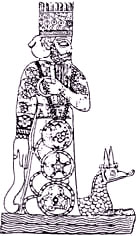
Figure 15
Physically present, resplendent in his
precious garments (Fig. 15), he was worshipped as Ilu (translated
“god” but literally meaning “the Lofty One”); his struggle to gain
supremacy over the other Anunnaki gods has been detailed in my book
The Wars of Gods and Men.
On the other hand, “Marduk” was a
celestial deity, a planetary god, who
in the heavens assumed the attributes, role, and credit for the
primordial creations that the Sumerians had attributed to Nibiru,
the planet whose most frequent symbolic depiction was that of a
winged disc (Fig. 16). The Assyrians, replacing Marduk with their
national god Ashur, combined the two aspects and depicted Ashur as
a
god within the winged disc (Fig. 17).
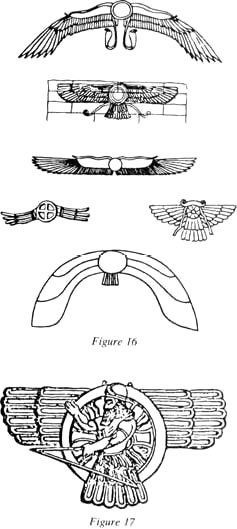
The Hebrews followed suit but, preaching monotheism and
recognizing—based on Sumerian scientific knowledge—the
universality of God, ingeniously solved the problem of duality
and of the multitude of Anunnaki deities involved in the events
on Earth by concocting a singular-but-plural entity, not an El
(the Hebrew equivalent of Ilu) but Elohim—a Creator who is
plural (literally “Gods”) and yet One. This departure from the
Babylonian and Assyrian religious viewpoint can be explained
only by a realization that the Hebrews were aware that the
deity who could speak to Abraham and Moses and the celestial
Lord whom the Sumerians called Nibiru were not one and the
same scientifically, although all were part of a universal,
everlasting, and omnipresent God—Elohim—in whose grand design for the
universe the path of each planet is its predetermined “destiny,” and
what the Anunnaki had done on Earth was likewise a predetermined
mission.
Thus was the handiwork of a universal God manifest in
Heaven and on Earth. These profound perceptions, which lie at the
core of the biblical adoption of the creation story, Enuma elish,
could be arrived at only by bringing together religion and science
while retaining, in the narrative and sequence of events, the
scientific basis.
But to recognize this—that Genesis represents not just religion but
also science—one must recognize the role of the Anunnaki and accept
that the Sumerian texts are not “myth” but factual reports. Scholars
have made much progress in this respect, but they have not yet
arrived at a total recognition of the factual nature of the texts.
Although both scientists and theologians are by now well aware of
the Mesopotamian origin of Genesis, they remain stubborn in brushing
off the scientific value of these ancient texts. It cannot be
science, they hold, because “it should be obvious by the nature of
things that none of these stories can possibly be the product of
human memory” (to quote N. M. Sama of the Jewish Theological
Seminary in Understanding Genesis).
Such a statement can be
challenged only by explaining, as I have repeatedly done in my
writings, that the information of how things began—including how Man
himself was created—indeed did not come from the memory of the
Assyrians or Babylonians or Sumerians but from the knowledge and
science of the Anunnaki/Nefilim. They too, of course, could not
“remember”1 how the Solar System was created or how Nibiru/Marduk
invaded the Solar System, because they themselves were not yet
created on their planet.
But just as our scientists have a good
notion of how the Solar System came about and even how the whole
universe came into being (the favorite theory is that of the Big
Bang), the Anunnaki/Nefilim, capable of space travel 450,000 years
ago, surely had the capacity to arrive at sensible scenarios of
creation; much more so since their planet, acting as a spacecraft
that sailed past all the outer planets, gave them a chance at
repeated close looks that were undoubtedly more extensive than our
Voyager “peeks.”
Several updated studies of the Enumu elish, such as
The Babylonian
Genesis by Alexander Heidel of the Oriental Institute, University of
Chicago, have dwelt on the parallels in theme and structure between
the Mesopotamian and biblical narratives. Both indeed begin with the
statement that the tale takes its reader (or listener, as in
Babylon) to the primordial time when the Earth and “the heavens” did
not yet exist. But whereas the Sumerian cosmogony dealt with the
creation of the Solar System and only then set the stage for the
appearance of the celestial Lord (Nibiru/Marduk), the biblical
version skipped all that and went directly to the Celestial Battle
and its aftermath.
With the immensity of space as its canvas, here is how the
Mesopotamian version began to draw the primordial picture:
When in the heights Heaven had not been named
And below earth had
not been called,
Naught but primordial Apsu, t
heir Begetter, Mummu,
and Tiamat,
she who bore them all.
Their waters were mingled
together.
No reed had yet been formed,
No marshland had appeared.
Even in the traditional King James version, the biblical opening is
more matter-of-fact, not an inspirational religious opus but a
lesson in primordial science, informing the reader that there indeed
was a time when Heaven and the Earth did not yet exist, and that it
took an act of the Celestial Lord, his “spirit” moving upon the
“waters.” to bring Heaven and Earth about with a bolt of light.
The progress in biblical and linguistic studies since the time of
King James has moved the editors of both the Catholic The New
American Bible and The New English Bible of the churches in Great
Britain to substitute the word “wind”—which is what the Hebrew ru’ach means—for the “Spirit of
God,” so that the last verse now
reads “a mighty wind swept over the waters.” They retain, however,
the concept of “abyss” for the Hebrew word Tehom in the original
Bible; but by now even theologians acknowledge that the reference is
to no other entity than the Sumerian Tiamat.
With this understanding, the reference in the Mesopotamian version
to the mingling “waters” of Tiamat ceases to be allegorical and
calls for a factual evaluation. It goes to the question of the
plentiful waters of Earth and the biblical assertion (correct, as we
shall soon realize) that when the Earth was formed it was completely
covered by water. If water was so abundant even at the moment of
Earth’s creation, then only if Tiamat was also a watery planet could
the half that became Earth be watery!
The watery nature of Tehom/Tiamat is mentioned in various biblical
references. The prophet Isaiah (51:10) recalled “the primeval days”
when the might of the Lord “carved the Haughty One, made spin the
watery monster, drained off the waters of the mighty Tehom.” The
psalmist extolled the Lord of Beginnings who “by thy might the
waters thou didst disperse, the leader of the watery monsters thou
didst break up.”
What was the “wind” of the Lord that “moved upon the face of the
waters” of Tehom/Tiamat? Not the divine “Spirit” but the satellite
of Nibiru/Marduk that, in the Mesopotamian texts, was called by that
term! Those texts vividly described the flashes and lightning
strokes that burst off Nibiru/Marduk as it closed in on Tiamat.
Applying this knowledge to the biblical text, its correct reading
emerges:
When, in the beginning,
The Lord created the Heaven and the Earth,
The Earth, not yet
formed,
was in the void,
and there was darkness upon Tiamat.
Then the Wind of the Lord swept upon its waters
and the Lord
commanded,
“Let there be lightning!”
and there was a bright light.
The continuing narrative of Genesis does not describe the ensuing
splitting up of Tiamat or the breakup of her host of satellites,
described so vividly in the Mesopotamian texts. It is evident,
however, from the above-quoted verses from Isaiah and Psalms, as
well as from the narrative in Job (26:7-13), that the Hebrews were
familiar with the skipped-over portions of the original tale.
Job
recalled how the celestial Lord smote “the helpers of the Haughty
One,” and he exalted the Lord who, having come
from the outer reaches of space, cleaved Tiamat (Tehom) and changed
the Solar System:
The hammered canopy He stretched out
in the place of Tehom,
The Earth suspended in the void;
He penned waters in its denseness,
without any cloud bursting. . . .
His powers the waters did arrest,
His energy the Haughty One did cleave.
His wind the Hammered Bracelet measured out,
His hand the twisting
dragon did extinguish.
The Mesopotamian texts continued from here to
describe how Nibiru/Marduk formed the asteroid belt out of Tiamat’s
lower half:
The other half of her
he set up as a screen for the skies;
Locking them together
as watchmen he stationed them. . . .
He bent Tiamat’s tail
to form the Great Band as a bracelet.
Genesis picks up the primordial tale here and describes the forming
of the asteroid belt thus:
And Elohim said:
Let there be a firmament in the midst of the waters and let it
divide the waters from the waters. And Elohim made the Firmament,
dividing the waters which are under the Firmament from the waters
which are above the Firmament. And Elohim called the Firmament
“Heaven.”
Realizing that the Hebrew word Shama’im is used to speak
of Heaven or the heavens in general, the editors of Genesis went
into some length to use two terms for “the Heaven” created as a
result of the destruction of Tiamat. What separated the “upper waters” from the “lower waters.” the Genesis
text stresses, was the Raki’a; generally translated “Firmament,” it
literally means “Hammered-out Bracelet.”
Then Genesis goes on to
explain that Elohim then called the Raki’a, the so called
Firmament,
Shama’im, “the Heaven”—a name that in its first use in the Bible
consists of the two words sham and ma’im, meaning literally “where
the waters were.” In the creation tale of Genesis, “the Heaven” was
a specific celestial location, where Tiamat and her waters had been,
where the asteroid belt was hammered out.
That happened, according to the Mesopotamian texts, when Nibiru/Marduk
returned to the Place of Crossing—the second phase of the battle
with Tiamat: “Day Two,” if you wish, as the biblical narrative does.
The ancient tale is replete with details, each of which is amazing
by itself. Ancient awareness of them is so incredible that its only
plausible explanation is the one offered by the Sumerians
themselves—namely, that those who had come to Earth from Nibiru were
the source of that knowledge. Modern astronomy has already
corroborated many of these details; by doing so, it indirectly
confirms the key assertions of the ancient cosmogony and astronomy:
the Celestial Battle that resulted in the breakup of Tiamat, the
creation of Earth and the asteroid belt, and the capture of Nibiru/Marduk
into permanent orbit around our Sun.
Let us look at one aspect of the ancient tale—the “host” of
satellites, or “winds,” that the “celestial gods” had. We now know
that Mars has two moons, Jupiter sixteen moons and several more
moonlets, Saturn twenty-one or more, Uranus as many as fifteen,
Neptune eight. Until Galileo discovered with his telescope the four
brightest and largest satellites of Jupiter in 1610, it was
unthinkable that a celestial body could have more than one such
companion—evidence Earth and its solitary Moon.
But here we read in the Sumerian texts that as Nibiru/ Marduk’s
gravity interacted with that of Uranus, the Invader “begot” three
satellites (“winds”) and Anu/Uranus “brought forth” four such moons.
By the time Nibiru/Marduk reached Tiamat, it had a total of seven
“winds” with which to attack Tiamat, and Tiamat had a “host” of
eleven—among them the “leader of the host,”
which was about to become an independently orbiting planet, our
eventual Moon. Another element of the Sumerian tale, of great
significance to the ancient astronomers, was the assertion that the
debris from the lower half of Tiamat was stretched out in the space
where she had once existed.
The Mesopotamian texts, and the biblical version thereof in Genesis,
are emphatic and detailed about the formation of the asteroid
belt—insisting that such a “bracelet” of debris exists and orbits
the Sun between Mars and Jupiter. But our astronomers were not aware
of that until the nineteenth century. The first realization that the
space between Mars and Jupiter was not just a dark void was the
discovery by Giuseppe Piazzi on January 1, 1801, of a small
celestial object in the space between the two planets, an object
that was named Ceres and that has the distinction of being the first
known (and named) asteroid.
Three more asteroids (Pallas,
Juno, and Vesta) were discovered by 1807, none after that until 1845, and
hundreds since then, so that almost 2,000 are known by now.
Astronomers believe that there may be as many as 50,000 asteroids at
least a mile in diameter, as well as many more pieces of debris, too
small to be seen from Earth, which number in the billions. In other
words, it has taken modern astronomy almost two centuries to find
out what the Sumerians knew 6,000 years ago.
Even with this knowledge, the biblical statement that the
“Hammered-out Bracelet,” the Shama’im—alias “the Heaven,” divided
the “waters which are below the Firmament” from the “waters which
are above the Firmament” remained a puzzle.
What, in God’s name, was
the Bible talking about?
We have known, of course, that Earth was a watery planet, but it has
been assumed that it is uniquely so. Many will undoubtedly recall
science-fiction tales wherein aliens come to Earth to carry off its
unique and life-giving liquid, water. So even if the ancient texts
had in mind Tiamat’s, and hence Earth’s, waters, and if this was
what was meant by the “water which is below the Firmament,” what
water was there to talk about regarding that which is “above the
Firmament”? We know—don’t we?-—that the asteroid belt had, indeed,
as the ancient text reported, divided the planets into two groups.
“Below” it are the Terrestrial, or inner, Planets; “above” it the
gaseous, or Outer, Planets. But except for Earth the former had
barren surfaces and the latter no surfaces at all, and the long-held
conventional wisdom was that neither group (again, excepting Earth)
had any water.
Well, as a result of the missions of unmanned spacecraft to all the
other planets except Pluto, we now know better. Mercury, which was
observed by the spacecraft Mariner 10 in 1974/75, is too small and
too close to the Sun to have retained water, if it ever had any. But
Venus, likewise believed to be waterless because of its relative
proximity to the Sun, surprised the scientists. It was discovered by
unmanned spacecraft, both American and Soviet, that the extremely
hot surface of the planet (almost 900 degrees Fahrenheit) was caused
not so much by its proximity to the Sun as by a “greenhouse” effect:
the planet is enshrouded in a thick atmosphere of carbon dioxide and
clouds that contain sulphuric acid.
As a result the heat of the Sun
is trapped and does not dissipate back into space during the night.
This creates an ever-rising temperature that would have vaporized
any water that Venus might have had. But did it ever have such water
in its past?
The careful analysis of the results of unmanned probes led the
scientists to answer emphatically, yes. The topographical features
revealed by radar mapping suggested erstwhile oceans and seas. That
such bodies of water might have indeed existed on Venus was
indicated by the finding that the “hell-like atmosphere,” as some of
the scientists termed it, contained traces of water vapor.
Data from two unmanned spacecraft that probed Venus for an extended
period after December 1978, Pioneer-Venus I and 2, convinced the
team of scientists that analyzed the findings that Venus “may once
have been covered by water at an average depth of thirty feet”;
Venus, they concluded (Science, May 7, 1982), once had “at least 100
times as much water in liquid form as it does today in the form of
vapor.”
Subsequent studies have suggested that some of that ancient
water was used up in the formation of the sulphuric acid clouds,
while some of it gave up its oxygen to oxidize the rocky surface of
the planet.
“The lost oceans of Venus” can be traced in its rocks; that
was the conclusion of a joint report of U.S. and Soviet scientists
published in the May 1986 issue of Science. There was indeed water
“below the Firmament,” not only on Earth but also on Venus.
The latest scientific discoveries have added Mars to the list of
inner planets whose waters corroborate the ancient statement. At the
end of the nineteenth century the existence of enigmatic “canals” on
Mars was popularized by the telescopic observations of the Italian
astronomer Giovanni Schiaparelli and the American Percival Lowell.
This was generally laughed off; and the conviction prevailed that
Mars was dry and barren. The first unmanned surveys of Mars, in the
1960s, seemed to confirm the notion that it was a “geologically
lifeless planet, like the Moon.”
This notion was completely
discredited when the spacecraft Mariner 9 launched in 1971, went
into orbit around Mars and photographed its entire surface, not just
the 10 percent or so surveyed by all the previous probes. The
results, in the words of the astronomers managing the project, “were
astounding.” Mariner 9 revealed that volcanoes, canyons, and dry
river beds abound on Mars (Plate C).
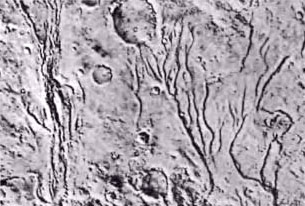
Plate C
“Water has played an active
role in the planet’s evolution,” stated Harold Masursky of the U.S.
Geological Survey, who headed the team
analyzing the photographs.
“The most convincing evidence was found
in the many photographs showing deep, winding channels that may have
once been fast-flowing streams... We are forced to no other
conclusion but that we are seeing the effects of water on Mars.”
The Mariner 9 findings were confirmed and augmented by the results
of the Viking 1 and Viking 2 missions launched five years later;
they examined Mars both from orbiters and from landers that
descended to the planet’s surface. They showed such features as
evidence of several floodings by large quantities of water in an
area designated Chryse Planitis; channels that once held and were
formed by running water coming from the Vallis Marineris area;
cyclical meltings of permafrost in the equatorial regions; rocks
weathered and eroded by the force of water; and evidence of
erstwhile lakes, ponds, and other “water basins.”
Water vapor was found in the thin Martian atmosphere;
Charles A. Barth, the principal scientist in charge of Mariner 9’s
ultraviolet measurements, estimated that the evaporation amounted to
the equivalent of 100,000 gallons of water daily. Norman Horowitz of
Caltech reasoned that “large amounts of water in some form have in
past eons been introduced to the surface and into the atmosphere of
Mars,” because that was required in order to have so much carbon
dioxide (90 percent) in the Martian atmosphere. In a report
published in 1977 by the American Geographical Union (Journal of
Geophysical Research, September 30, 1977) on the scientific results
of the Viking project, it was concluded that,
“a long time ago giant
flash floods carved the Martian landscape in a number of places; a
volume of water equal to Lake Erie poured... scouring great
channels.”
The Viking 2 lander reported frost on the ground where it came to
rest. The frost was found to consist of a combination of water,
water ice, and frozen carbon dioxide (dry ice). The debate about
whether the polar ice caps of Mars contain water ice or dry ice was
resolved in January 1979 when JPL scientists reported at the 2nd
International Colloquium on Mars, held at the California Institute
of Technology (Caltech) in Pasadena, that “the north pole consists
of water ice,” though not so the south pole.
The final NASA report after the Viking missions (Mars: The Viking Discoveries) concluded that “Mars once had
enough water to form a layer several meters deep over the whole
surface of the planet.” This was possible, it is now believed,
because Mars (like Earth) wobbles slightly as it spins about its
axis. This action results in significant climatic changes every
50,000 years. When the planet was warmer it may have had lakes as
large as Earth’s Great Lakes in North America and as much as three
miles deep. ‘This is an almost inescapable conclusion,” stated
Michael H. Carr and Jack McCauley of the U.S. Geological Survey in
1985. At two conferences on Mars held in Washington, DC, in July
1986 under the auspices of NASA.
Walter Sullivan reported in The New
York Times, scientists expressed the belief that "there is enough
water hidden in the crust of Mars to theoretically flood the entire
planet to an average depth of at least 1,000 feet.” Arizona State
University scientists working for NASA advised Soviet scientists in
charge of their country’s Mars landing projects that some deep
Martian canyons may still have flowing water in their depths, or at
least just below the dry riverbeds. What had started out as a dry
and barren planet has emerged, in the past decade, as a planet where
water was once abundant—not just passively lying about but flowing
and gushing and shaping the planet’s features.
Mars has joined Venus
and Earth in corroborating the concept of the Sumerian texts of
water “below the Firmament,” on the inner planets. The ancient
assertion that the asteroid belt separated the waters that were
below the Firmament from those that were above it implies that there
was water on the celestial bodies that are located farther out. We
have already reviewed the latest discoveries of Voyager 2 that
confirm the Sumerian description of Uranus and Neptune as “watery.”
What about the other two celestial bodies that are orbiting between
those two outer planets and the asteroid belt, Saturn and Jupiter?
Saturn itself, a gaseous giant whose volume is more than eight
hundred times greater than that of Earth, has not yet been
penetrated down to its surface—assuming it has, somewhere below its
vast atmosphere of hydrogen and helium, a solid or liquid core. But
its various moons as well as its breathtaking rings (Fig. 18) are
now known to be made, if not wholly then in large part, of water ice
and perhaps even liquid water.
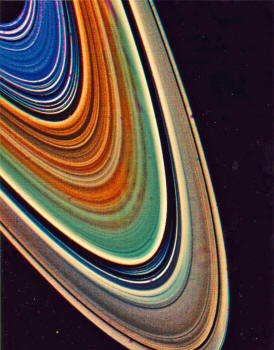
Figure 18
Originally, Earth-based observations of Saturn showed only seven
rings; we now know from space probes that there are many more, with
thinner rings and thousands of ringlets filling the spaces between
the seven major rings; all together they create the effect of a disk
that, like a phonograph record, is “grooved” with rings and
ringlets. The unmanned spacecraft Pioneer 11 established in 1979
that the rings and ringlets consist of icy material, believed at the
time to be small pieces of ice a few inches in diameter or as small
as snowflakes. What was originally described as “a carousel of
bright icy particles” was revealed, however, by the data from
Voyager 1 and Voyager 2 in 1980 and 1981 to consist of chunks of ice
ranging from boulder size to that of “big houses.” We are seeing “a
sea of sparkling ice,” JPL’s scientists said.
The ice, at some primordial time, had been liquid water.
The several larger moons of Saturn at which the three spacecraft,
especially Voyager 2, took a peek, appeared to have much more water,
and not only in the form of ice. Pioneer 11 reported in 1979 that
the group of inner moons of Saturn—
Janus, Mimas, Enceladus, Tethys, Dione, and Rhea—appeared to be “icy
bodies... consisting largely of ice.” Voyager 1 confirmed in 1980
that these inner satellites as well as the newly discovered moonlets
were “spheres of ice.” On Enceladus, which was examined more
closely, the indications were that its smooth plains resulted from
the filling in of old craters with liquid water that had oozed up to
the surface and then frozen.
Voyager 1 also revealed that Saturn’s outer moons were ice covered.
The moon lapetus, which puzzled astronomers because it showed dark
and bright portions, was found to be “coated with water ice” in the
bright areas. Voyager 2 confirmed in 1981 that lapetus was
“primarily a ball of ice with some rock in its center.”
The data,
Von R. Eshleman of Stanford University concluded, indicated that
lapetus was 55 percent water ice, 35 percent rock, and 10 percent
frozen methane.
Saturn’s largest moon, Titan—larger than the planet
Mercury—was found to have an atmosphere and a surface rich in
hydrocarbons. But under them there is a mantle of frozen ice, and
some sixty miles farther down, as the internal heat of this
celestial body increases, there is a thick layer of water slush.
Farther down, it is now believed, there probably exists a layer of
bubbling hot water more than 100 miles deep. All in all, the
Voyagers’ data suggested that Titan is 15 percent rock and 85
percent water and ice.
Is Saturn itself a larger version of Titan, its largest moon? Future
missions might provide the answer. For the time being it is clear
that wherever the modern instruments could reach—moons, moonlets,
and rings—there was water everywhere. Saturn did not fail to confirm
the ancient assertions.
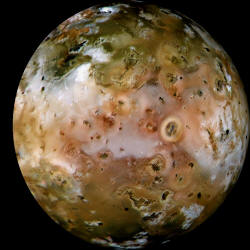 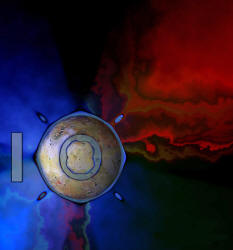
Figure 19
Jupiter was investigated by Pioneer 10 and Pioneer 11 and
by the two Voyagers. The results were no different than at
Saturn. The giant gaseous planet was found to emit immense
amounts of radiation and heat and to be engulfed by a thick
atmosphere that is subject to violent storms. Yet even this
impenetrable envelope was found to be constituted primarily of
hydrogen, helium, methane, ammonia, water vapor, and probably
droplets of water, somewhere farther down inside the thick
atmosphere there is liquid water, the scientists have concluded.
As
with Saturn, the moons of Jupiter proved more fascinating,
revealing, and surprising than the planet itself. Of the four
Galilean moons,
Io, the closest to Jupiter (Fig. 19), revealed
totally unexpected volcanic activity. Although what the volcanoes
spew is mostly sulphur based, the erupted material contains some
water. The surface of Io shows vast plains with troughs running
through them, as if they had been carved by running water. The
consensus is that Io has “some internal sources of water.”
Europa, like Io, appears to be a rocky body, but its somewhat lower
density suggests that it may contain more internal water than Io. Its surface shows a latticework of veinlike
lines that suggested to the NASA teams shallow fissures in a sea of
frozen ice.
A close look at Europa by Voyager 2 revealed a layer of
mushy water ice under the cracked surface. At the December 1984
meeting of the American Geophysical Union in San Francisco, two
scientists (David Reynolds and Steven Squyres) of NASA’s Ames
Research Center suggested that under Europa’s ice sheet there might
exist warmer oases of liquid water that could sustain living
organisms.
After a reexamination of Voyager 2 photographs, NASA
scientists tentatively concluded that the spacecraft witnessed
volcanic eruptions of water and ammonia from the moon’s interior.
The belief now is that Europa has an ice covering several miles
thick “overlaying an ocean of liquid water up to thirty miles deep,
kept from freezing by radioactive decay and the friction of tidal
forces.” Ganymede, the largest of Jupiter’s moons, appears to be
covered with water ice mixed with rock, suggesting it has undergone
moonquakes that have cracked its crust of frozen ice. It is thought
to be made almost entirely of water ice, with an inner ocean of
liquid water near its core.
The fourth Galilean moon, Callisto—about
the size of the planet Mercury—also has an ice-rich crust; under it
there are mush and liquid water surrounding a small, rocky core.
Estimates are that Callisto is more than 50 percent water. A ring
discovered around Jupiter is also made mostly, it not wholly, of ice
particles.
Modern science has confirmed the ancient assertion to the
fullest: there indeed have been “waters above the Firmament.”
Jupiter is the Solar System’s largest planet—as large as 1,300
Earths. It contains some 90 percent of the mass of the complete
planetary system of the Sun. As stated earlier, the Sumerians called
it KI.SHAR, “Foremost of the Firm Lands,” of the planetary bodies.
Saturn, though smaller than Jupiter, occupies a much larger portion
of the heavens because of its rings, whose “disk” has a diameter of
670,000 miles. The Sumerians called it AN.SHAR, “Foremost of the
Heavens.” Evidently they knew what they were talking about.
SEEING THE SUN
When we can see the Sun with the naked eye, as at dawn or at sunset,
it is a perfect disk. Even when viewed with telescopes, it has the
shape of a perfect globe. Yet the Sumerians depicted it as a disk
with a triangular rays extending from its round surface, as seen on
cylinder seal VA/243 (Plate B and Fig. 6a). Why?
In 1980 astronomers of the High Altitude Observatory of the
University of Colorado took pictures of the Sun with a special
camera during an eclipse observed in India. The pictures revealed
that because of magnetic influences, the Sun’s corona gives it the
appearance of a disk with triangular rays extending from its
surface—just as the Sumerians had depicted millennia earlier.
In January 1983, I brought the “enigmatic representation” on the
Sumerian cylinder seal to the attention of the editor of Scientific
American, a journal that reported the astronomers’ discovery. In
response, the editor, Dennis Flanagan, wrote to me on January 27,
1983:
“Thank you for your letter of January 25.
“What you have to say is most interesting, and we may well be able
to publish it.”
“In addition to the many puzzles posed by this depiction,”
1 had
written in my letter, “foremost of which is the source of the
Sumerian knowledge, is now their apparent familiarity with the true
shape of the Sun’s corona.”
Is it the need to acknowledge the source
of Sumerian knowledge that is still holding up publication of what
Scientific American has deemed “most interesting”?
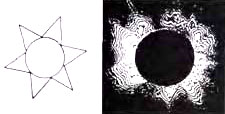
Back to Contents
|







